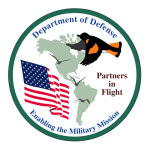Some sites are exceptionally important – even essential – for bird conservation. Directing protection and management efforts towards these sites is crucial if viable populations of many species are to survive in the long-term. Conservationists have long understood this fact, but only in recent years has a program emerged to recognize these sites formally.
From its start in Europe in the 1980s, the Important Bird Areas (IBA) concept has been a success, leading to the recognition and protection of some 3,500 sites worldwide. The worldwide IBA program is administered by BirdLife International, through a network of Partners. BirdLife Partners operate in over one hundred countries and territories worldwide, some with more than one Partner.
 The first U.S. BirdLife Partner, American Bird Conservancy, launched its Important Bird Areas Program in 1995. The American Bird Conservancy IBA program concentrated on identifying and documenting the very top sites throughout all 50 states – those of significance on a global level. Many kinds of sites are represented: National Wildlife Refuges, National Parks and Forests, Department of Defense lands, state lands, conservation organization lands, and some private lands. Some of these sites are important because they are links along a migratory pathway. Other sites are important quite independent of any other site, and a few – most notably several in Hawaii – support species found nowhere else on earth.
The first U.S. BirdLife Partner, American Bird Conservancy, launched its Important Bird Areas Program in 1995. The American Bird Conservancy IBA program concentrated on identifying and documenting the very top sites throughout all 50 states – those of significance on a global level. Many kinds of sites are represented: National Wildlife Refuges, National Parks and Forests, Department of Defense lands, state lands, conservation organization lands, and some private lands. Some of these sites are important because they are links along a migratory pathway. Other sites are important quite independent of any other site, and a few – most notably several in Hawaii – support species found nowhere else on earth.
 National Audubon Society also launched its IBA initiative in 1995, establishing programs state by state. State-based IBA programs provide conservation leaders with the flexibility to tailor the program to their individual state needs, and they also give Audubon members and local volunteers the greatest opportunities to protect sites in their communities. Now the current BirdLife Partner in the U.S., the Audubon IBA program focuses on sites at the global, continental, and state level.
National Audubon Society also launched its IBA initiative in 1995, establishing programs state by state. State-based IBA programs provide conservation leaders with the flexibility to tailor the program to their individual state needs, and they also give Audubon members and local volunteers the greatest opportunities to protect sites in their communities. Now the current BirdLife Partner in the U.S., the Audubon IBA program focuses on sites at the global, continental, and state level.
The IBA criteria are divided into four categories based on vulnerability and/or responsibility. For a site to be identified as an IBA, it must, during at least some part of the year, contain critical habitat that supports:
- Species of conservation concern (e.g. threatened and endangered species), such as Piping Plover, Red-cockaded Woodpecker, or Kirtland’s Warbler;
- Range-restricted species (species vulnerable because they are not widely distributed), such as Tricolored Blackbird, Yellow-billed Magpie, or Brown-capped Rosy-Finch;
- Species that are vulnerable because their populations are concentrated in one general habitat type in a Bird Conservation Region or biome, such as Black Rail, Mountain Plover, or Henslow’s Sparrow;
- A significantly large concentration of breeding, migrating or wintering birds, including waterfowl, seabirds, wading birds, raptors or landbirds.
The goal of the IBA program is not just to recognize the sites as important, but to mobilize the resources needed to protect them. The IBA recognition is an important first step in raising awareness among the public, and among land managers, to the importance of each site and its value to bird conservation. Despite the fact that most IBAs have at least some protected status, an initial analysis of threats to IBAs found that many face a barrage of serious problems. Among the most critical are introduced species, soil erosion, suburban sprawl, over-use for recreation, lack of funding for management and infrastructure, groundwater insufficiency, water diversion, water drainage, excessive disturbance, overgrazing, pollution, pesticides, and fire. Identification as an IBA entails no legal or management requirements. DoD sites identified as IBAs are unique in the fact that they already have a conservation plan in place — the installation’s Integrated Natural Resources Management Plan.

